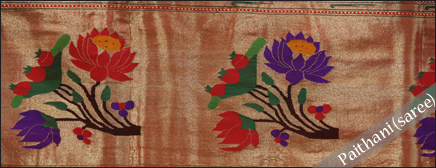 |
| Paithani |
 |
| Next to perhaps only the rich gold brocade of Banaras the silken gold
embroidered sari of Paithan, known as Paithani, stands high among the most
precious and celebrated textiles of India. Like the patola of Patan (Gujarat)
the paithani of Paithan is a ceremonial sari worn only on special occasions.
Maratha women of older generations used to prefer the paithani sari with coin
motifs known as buties, spread all over the fabric. Such a sari is called the
shawl. The bright green shalus with red borders and elaborate pallus were
considered auspicious and worn on occasions like marriages. The pallu (or
pallav) as well as the borders of paithani have floral and creeper motifs on a
background of rich gold. Such sarees are worn by brides. Even today the
knowledgeable Maharashtrain ladies who have aesthetic taste and reasonable
wealth would crave for a paithani shalu as a pride possession in their
wardrobe. |
| The design woven in its border and its pallu is a great speciality of paithani.
Richly decorated pallu projects a variety of motifs known as asavali,
bangdimors, shikar-khana, akroti, gazwel, Ajanta Lotus and human-parinds. These
paithanis can also be fringed with pearls or precious stones. They can be woven
in cotton also. |
| History tells us that the Peshwas had a great fascination for paithani
textiles. There are a number of letters in the Peshwa Daftar to give evidence
of this. In one such letter dated 7.12.1768 Madhavarao Peshwa asked for the
supply, pomegranate and pink colours. The Nizam of Hyderbad had visited Paithan
several times as he was much attracted to the richness of paithani textile. It
is believed that his daughter-in-law, Begum Nilofar had introduced some new
motifs in the border as well as to designs of the pallu. |
| The paithani technique cannot be called simple. In fact it is a very
complicated one. Here, on a zari warp thread, the weft was never thrown across,
but was interlocked with different colours, somewhat similar in technique to
tapestry weave, which also created the same effect on both sides. They wove
complicated patterns of mythical swans, peacocks, stylized parrots and
flowering bushes with star like flowers. These techniques combined with fine
cotton weaves and soft colours, created a sophisticated textile. |
| It appears that the execution of this costly and rich silken gold embroidered
sari must have originated from Paithan, hence the textile was called Paithani.
But the production of paithani soon spread in other places like Yeols, Pune,
Nasik and Malegaon. However, Yeola remained prominent and was particularly
known for its kayari (mango mofit) pallur paithani. |
| During the last quarter of the 19th Century, George C.M. Birdwood,
the British scholar, had compiled and published a book on the Arts of India
(1880) in which Yeola was mentioned prominently for high quality, silken,
gold-embroidered saris, but nowhere did he mention anything about the paithani
and Paithan. Similarly, the doyen of Indian art, Dr. Anand Coomaraswamy in his
book, History of Indian and Indonesian Art, published in 1927 wrote about
patola, ikat, kimkhwab (brocade), jamdani and other types of Indian textile,
but could not discover the paithani. |
| From this it appears that during the turn of the last century, the production of
paithani in Paithan must have received a great setback for some reason or the
other. But Yeola weavers must have survived and continued their work to give
evidence of their rich craftsmanship. Hence they were taken note of by
historians. However, due to special efforts made after Independence, the rich
craft of executing paithani has been revived and paithani shalu has once again
become a household name in Indian textiles. |
|
|
|